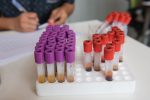Protein a potential biomarker of Spinraza treatment responses

In adults with spinal muscular atrophy (SMA), changes in the bloodstream in the levels of a protein called LARGE1 matched treatment responses to Spinraza (nusinersen), a study suggested.
Further, LARGE1 levels in the cerebrospinal fluid (CSF) — the liquid that surrounds the brain and spinal cord — were also able to distinguish Spinraza responders from non-responders among adult patients when measured before treatment, the researchers found.
Conversely, when measured after the start of treatment, LARGE1 CSF levels were able to differentiate pediatric Spinraza responders from non-responders.
“Our combined data unraveled LARGE1 as a protein dysregulated in [blood] and CSF of SMA-patients … holding the potential to serve as a disease marker for SMA and enabling to differentiate between patients responding and non-responding to therapy with [Spinraza],” the researchers wrote.
The study, “Alteration of LARGE1 abundance in patients and a mouse model of 5q-associated spinal muscular atrophy,” was published in the journal Acta Neuropathologica.
Researchers cite need for treatment biomarkers for SMA adults
In SMA, a lack or insufficient levels of the survival motor neuron (SMN) protein — essential for keeping motor neurons healthy — leads to muscle weakness and wasting. Motor neurons are specialized nerve cells that are responsible for controlling voluntary movements.
Disease-modifying therapies, or DMTs, like the approved SMA treatment Spinraza, are designed to boost SMN production and slow disease progression.
Still, there remains a need for biomarkers associated with disease processes that can objectively assess a patient’s response to treatment, particularly among adults with SMA.
“Although the therapeutic options for SMA have considerably changed, treatment responses may differ thus underlining the persistent need for validated biomarkers,” the researchers wrote.
To address this need, a team led by scientists at the University Hospital Essen, in Germany, conducted a proteomic-based discovery study. In medicine, a proteomic profile may be used to diagnose a disease or to see how well the body responds to therapy.
This study involved the large-scale analysis of proteins in SMA patient samples to identify those whose levels changed in response to treatment.
Although the therapeutic options for SMA have considerably changed, treatment responses may differ thus underlining the persistent need for validated biomarkers.
Proteomic profiling was first carried out on CSF samples collected from 14 adults with SMA type 3 — a milder form of the genetic disease — before and after Spinraza treatment.
After 180 days, or about six months, on the therapy, two patients were classified as non-responders due to a lack of motor improvement.
CSF analysis detected 17 proteins that were significantly changed after treatment between responders and non-responders. One was LARGE1. Given its association with other neuromuscular diseases, the team selected LARGE1 as a candidate for further study.
LARGE1 seen to differentiate Spinraza treatment response
To validate the team’s initial findings, LARGE1 levels were measured in CSF samples from 32 people with SMA: 10 pediatric patients who responded to treatment, four who did not, and 18 adult patients.
CSF LARGE1 levels also were measured in pediatric and adult patients with inflammatory and non-inflammatory diseases affecting the nervous system; these patients served as controls.
LARGE1 levels significantly increased after 180 days of treatment among adult SMA patients, regardless of treatment response. However, LARGE1 levels in adults who did not respond to Spinraza were significantly lower than those measured in responders and controls before treatment, called the study’s baseline.
In pediatric patients, high LARGE1 levels measured before treatment were more pronounced than in adults and were independent of SMA type or response to treatment. LARGE1 levels further increased in pediatric patients responding to therapy across all SMA types, whereas non-responders showed a decrease in LARGE1 levels by day 180.
In eight adult patients, an increase in LARGE1 levels was accompanied by improvements in gross motor function, as assessed by the Hammersmith Functional Motor Scale Expanded (HFMSE) scale. Similarly, four of six evaluable pediatric patients showed an increase in LARGE1 levels accompanied by motor improvements, as indicated by the Hammersmith Infant Neurological Examination (HINE).
No correlations were detected between LARGE1 levels and upper limb motor function, as assessed by the Revised Upper Limp Module (RULM).
The researchers then measured LARGE1 levels in blood samples collected from adult and pediatric SMA patients to assess the protein’s ability to serve as a minimally invasive disease biomarker.
Only adult patients who experienced a clinical benefit from treatment had a profound and significant increase in LARGE1 levels in the bloodstream. By contrast, no increases in LARGE1 blood levels were observed in pediatric patients, regardless of SMA type.
Lastly, the team measured LARGE1 levels in spinal cord samples of SMN-deficient mice. This model, representing late SMA onset, showed evidence of motor neuron loss beginning 28 days after birth up to day 42, which then remained unchanged until day 52. The analysis revealed that increased LARGE1 levels were associated with motor neuron loss that occurred by day 42. Muscle samples from the lower leg also showed elevated LARGE1 levels by day 52, but not earlier.
Overall, according to the researchers, levels of LARGE1 in the CSF were able to “distinguish between SMA-cases responding and not responding to [Spinraza] in both … adult patients (based on baseline level) and pediatric patients (based on level 180 days post-treatment).”
“Moreover, LARGE1 serves as a (minimal invasive) [blood] biomarker only in adult SMA patients and here even enables to predict treatment response based on baseline protein level,” the team added.
The post Protein a potential biomarker of Spinraza treatment responses appeared first on SMA News Today.



